-
Update on the New Supergirl Blu-ray
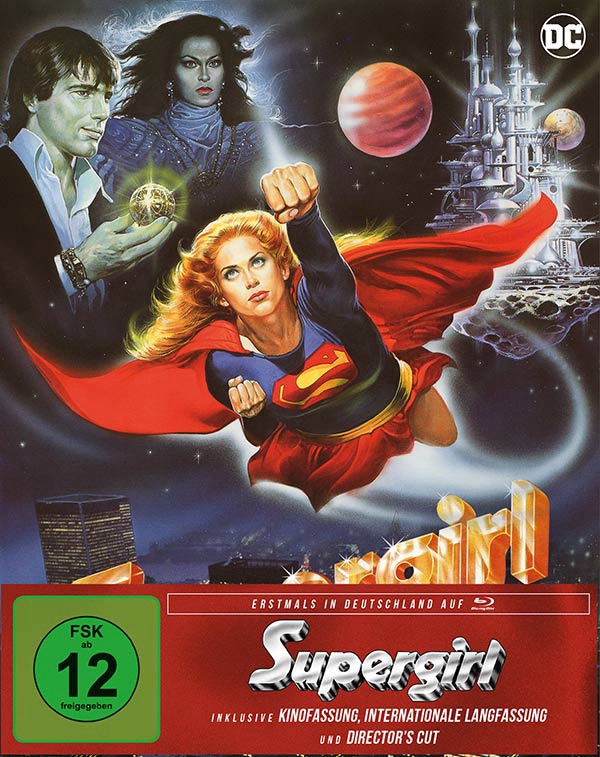
Lovely package, but don’t judge this book by its cover alone. Recently I published my latest blog on the release of the new Supergirl Blu-ray import from Germany (and also Austria), and as soon as it dropped, comments came out of the woodwork. And let me just say at the start that this was not what I expected.
To briefly recap, Plaion Pictures recently came out with a new 2-disc version of the ill-received 1984 screen debut of the Maid of Steel, which included three different cuts of the film: the 124-minute international cut, the 138-minute director’s cut, and the theatrical cut (which according to the specs on the Blu-ray cover ran approximately 91 minutes long). It also contained many of the bonus features that were first included on the 2002 DVD release from Anchor Bay Entertainment. To have all of that in a single 2-disc collection would have been nice, right?
Wrong. Wrong. WRONG.
As I previously indicated, many of the bonus features from the Anchor Bay release have been ported to this new set, but missing in action are three of the theatrical trailers, including the initial announcement trailer, the international trailer, and the UK theatrical trailer.
The original announcement teaser, which uses the main (end) theme from Superman. I kinda have a fondness for this one, mainly because of the music. The UK trailer as seen on the Anchor Bay DVD. Also missing in action are the three TV spots and the talent bios from that set. In my previous commentary I likened this set to a meal, and how these side potatoes and vegetables were left out of the meal, if you understand my analogy.
One of the three TV spots that was included on the Anchor Bay DVD. Now it would have been all fine and dandy if the omissions had been limited to just that, but here’s where the meal goes wrong. Let me put it this way: have you ever had a meal and you were promised soup, but then they bring you out a side of beets that you didn’t ask for? (That actually happened to me!) Well, when you get to disc 2 of this Blu-ray set, what you see is not what you get.
One fan I spoke with online, Matthew Vincenty, had inquired about the film being released on Blu-Ray in high definition format, and this is the response he received from Plaion Pictures:

Matthew informed me that he was told by Plaion Pictures that all three cuts were mastered in HD format. Furthermore, he had been informed that the disc would not ship from Germany, and like me he wound up ordering it from eBay, which was shipped from Germany.
Upon further deep diving on the Blu-ray.com message board, a number of people have chimed in with their opinions and questions about the Blu-Ray, and here is what has surfaced:
The director’s cut appears to be upscaled to Blu-ray from the previous DVD releases. The only thing I can compare it to is when the 10-part “Face of the Enemy” web series was included on the fourth season Blu-ray of Battlestar Galactica in Japan—essentially, while it wasn’t as sharp as the rest of the content, it looked pretty good. While it’s the first time that the director’s cut is presented in a Blu-ray format, it would have been nice if they had taken the time to properly give it the HD Blu-ray treatment. Maybe they didn’t have the tools, or maybe something is in the quality of the print that all they could do is upscale it. (It’s probably the same concerns that the Warner Archive had, which is why all they could give fans was that cut in DVD format with the international cut on Blu-ray.) E for effort. But still, truth in promotion, people.



The German theatrical version, which is included on the second disc, is a mish mash of sources, with some scenes cribbed from a 4:3 copy of an inferior VHS tape spliced into the movie. Also, there are some extremely noticeable jumps in footage from one shot to another within the first 30 minutes of the film, particularly in the flying scenes. Add to it the fact that during the end credits there is a very noticeable jump in the credits. That’s not good.
Going back to the meal analogy, it’s like being promised a New York strip and a ribeye, and you get chopped steak and something that’s really undercooked, and then they throw in the beets, which is not what you ordered in the first place… you see where I’m heading with this?
Now the question is, why use the 91-minute German cut? I did a little digging on IMDb, and I came across this bit of information about the different cuts of the film:

And why use a print mixed with 4:3 footage and jump cuts in the footage and the end credits? It makes zero sense whatsoever.
Still MIA is the 105-minute US theatrical version, which, apart from its release on VHS in 1985 and its later airings on HBO in 1986, has not been issued on DVD or Blu-Ray in any format whatsoever. Why didn’t Plaion locate the US cut and remaster it and give it a proper introduction on Blu-ray to begin with?
What’s also intriguing is the mention of the 150-minute original cut. Where is this version of the film? I’d heard about it from one other person, and it wasn’t until I saw these stats on IMDb that I saw the facts for myself. And what scenes are in this cut of the film that aren’t in any other cut? Twelve minutes of footage may seem negligible, and it may be just fluff filler material. Such a print apparently has not emerged officially, and the closest I can assume of its existence is the 138-minute director’s cut and comparing it with any scenes in the 124-minute international version that didn’t make that cut, and putting them back in (if it’s possible).
Plaion Pictures had something really promising on their hands with this Supergirl Blu-Ray, and in the end they underdelivered not only by scrimping on the extras but by really screwing up the presentation of the theatrical version, with poor quality framing and mastering issues. The usage of a poor quality VHS print on a Blu-ray, and poorly edited at that… I don’t know what the box office returns were in Germany, but if looked that bad on VHS, I can just imagine what fans were thinking when they saw a badly edited movie in the theater and later probably got their hands on the US cut, the Japanese VHS or laserdisc, or the Anchor Bay DVD. And the upscaling of the director’s cut gets a pass but just barely.
This, simply put, is not—I repeat, NOT—how you treat a film on disc. Period. The only thing that makes it look good is the digibook presentation and the textual content from Christian Heiss.
The best thing to do is hold onto your copies of the Anchor Bay DVD (whether you have the 2-disc set or just the single-disc international DVD) and the Warner Archive Blu-ray combo for the best quality presentation of the film and the most complete presentation of the bonus features. Maybe one day we’ll get a better and more comprehensive package, but until then don’t hold your breath.
And if anyone has a good quality transfer of the US cut, let’s talk.


-
A Look at the New “Supergirl” Blu-ray
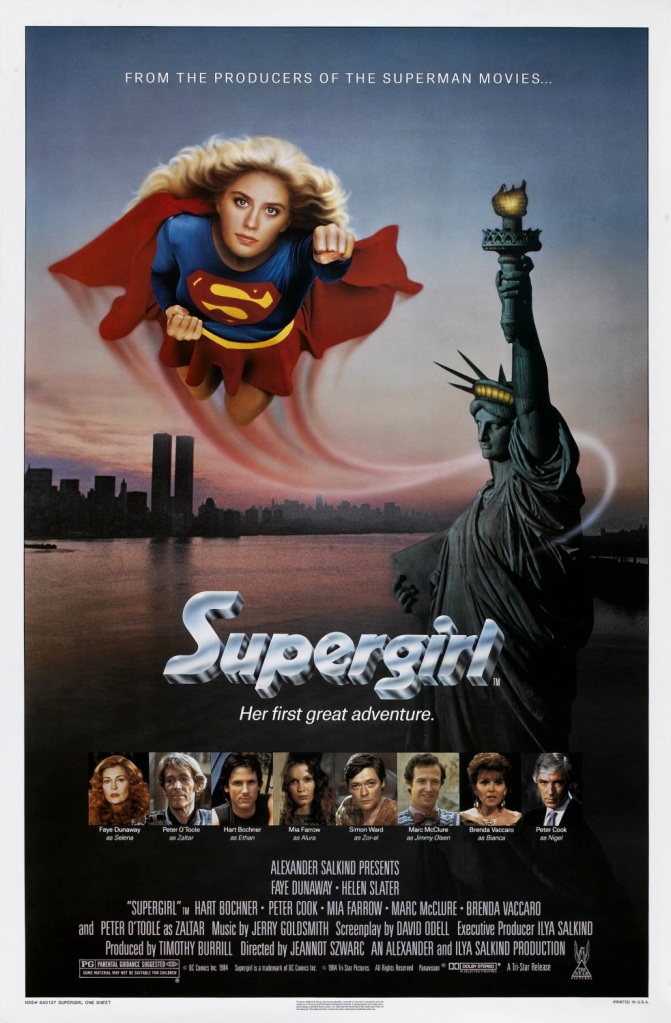
It seems like it’s been a lot more than 40 years since the Supergirl spinoff film was released in theaters, but it’s not. It was 1984 that saw the release of this film spinoff from the successful Superman trilogy from producers Alexander and Ilya Salkind. And now, to celebrate the film’s 40th anniversary, a brand new Blu-ray release of Supergirl has appeared out of left field, and boy, is this one we never expected to see happen!
The film origins of Supergirl go all the way back to late 1980 and early 1981, when Ilya Salkind wrote two story proposals for what would eventually become Superman III. While Warner Bros. executives dismissed the story proposals, one of the elements that appeared was Supergirl’s arrival on Earth, her introduction to her big cousin Superman, and a really wonky storyline that saw the Kryptonian cousins fall in love with each other. (Insert requisite Southern joke here.) Another element of the story outline, the departure of Lois Lane and the arrival of Lana Lang, would make it into the final film, while the principal villain of Brainiac would prominently feature in the script for Superman Reborn (which would ultimately be shelved) and the first volume of the highly successful Superman ‘78 comic book series in 2021-22. I previously reviewed the audio narration of this treatment in an earlier blog installment, and I don’t know if the audio is still available on Spotify, but all I can say is steer clear of this mess.

Trust me. It’s that bad. While Superman III was nearing the end of filming in 1982, the Salkinds recruited writer David Odell to pen the script for Supergirl, penning two drafts that included Superman in a few scenes and being captured by the film’s main villain, the witch Selena, before being rescued by his younger cousin. It was intended for Christopher Reeve to return in an extended supporting role, but once he read the script, he chose not to do the film, feeling that he had finished his time with the Superman film series. I’ve seen a few script pages that featured Superman’s involvement in the Supergirl project, and it’s quite minimal indeed.

Would you have wanted to see Christopher Reeve in a Superman cameo in this film? From there the script would be rewritten to feature a returning Marc McClure as Jimmy Olsen (although a couple of brief mentions of Superman would appear in the final film, along with a quick flyby—pun intended—of a Superman poster and a brief tip of the hat to John Williams’ classic theme). In a 2006 interview in the documentary You Will Believe: The Cinematic Saga of Superman, McClure remarked, “In the initial script, I was the only one in there…and I kind of was wondering, is Supergirl Superman’s sister? And it got to a point where, why was I even there?”
Originally, Richard Lester had been approached to direct the film, but he turned it down. Ultimately, under the direction of Jeannot Szwarc, who had directed Reeve in the 1980 romantic drama Somewhere in Time, and whom Reeve had recommended to direct Supergirl, shooting occurred in the spring and summer of 1983 in England and Scotland. Szwarc recalled in 2006 wanting to intentionally take Supergirl in a different direction from the Superman movies. “We can do strength, and maybe we can do grace. We can do something which is more lyrical, especially in the flying. And that’s, I think, the idea of when she discovers her powers and this kind of ballet came.”

Ilya Salkind, Jerry Goldsmith, and Jeannot Szwarc. Dozens of actresses had auditioned for the lead role of Supergirl, aka Kara, aka Linda Lee, including Brooke Shields, Melanie Griffith, and Demi Moore, before the Salkinds finally settled on a newcomer, Helen Slater, for the role. In all, over 350 actresses auditioned for the role, almost double the number of actors, athletes, and musicians who were considered in 1976-77 for the lead in Superman! Slater had auditioned four times for the role, once in a homemade Supergirl costume. She was offered $75,000 and a three-picture deal in the role (which ultimately didn’t happen).
For the principal villain of Selena, Dolly Parton was offered $7 million, which she turned down. Let’s face it, America’s lovable queen of country music as a villain? She couldn’t see it happening. Ultimately, the role went to Faye Dunaway, who would camp it up through the film. Dudley Moore was offered $4 million to play the Kandorian scientist Zaltar, but it went to Peter O’Toole (and his vast array of turtleneck sweaters) instead. John Travolta was offered the supporting role of Ethan, a beefcake who falls for Supergirl, but it was given to Hart Bochner instead. Demi Moore was later cast as Lucy Lane, the younger sister of Lois Lane (and there’s something we’ll discuss later), but she bowed out at the last minute, and Maureen Teefy was cast in the part. It seemed like the whole film was a series of casting changes all over the place.

Yes, this almost happened! As if the drama wasn’t occurring enough in the casting, behind the scenes there was just as much drama. The film’s original producer, Alyssa Cartagena, frequently clashed with Ilya Salkind over issues such as costume design and publicity and marketing, and she was ultimately released from the picture, with Timothy Burrill taking over as producer. Christopher Reeve had bowed out three months before filming began, not feeling it was right for him to do what amounted to a glorified cameo, which necessitated all of the script rewrites. In the end, Reeve had foreseen the wisdom of bowing out and made the right call. And during the production on Supergirl, Superman III was released to middling critical and commercial box office reception in June 1983, which, when compared to the first two films, didn’t help matters on the $35 million production on the spinoff.
At least the film succeeds in some of its comic book origins, with the pocket city of Kandor existing in its own microverse, the depiction of the interior of the Phantom Zone as a wasteland of horrors, and the relationship between Lucy Lane and her older sister Lois. And yet, at times, logic seems to be completely thrown out the window in this movie. Here, we have to go back to that line that Margot Kidder says in the first Superman film: “I’ve seen how the other half lives. My sister, for instance… three kids, two cats, and one mortgage.” Unless Kidder was ad libbing on set, there’s no way that her sole sister, living in a high school-aged boarding school, would be married with three children. And how is it that, in her journey from the microverse to Earth, Kara grows from a teeny weeny girl no bigger than the size of a dot into a fully grown Earth-sized teenager, then goes back at the end of the movie being dot-sized all over again? And in her final confrontation with Selena, when she tornado spins around her, she magically shrinks in size to create the micro tornado! Maybe it’s the realist in me that’s reading too much into it here, but the sense of verisimilitude that Richard Donner and Tom Mankiewicz set forth in the first two Superman films seems to be forgotten here, as it’s all about camp humor and supporting actors chewing their scenes throughout. Not to mention all of Peter O’Toole’s rambling lines and oversized turtleneck sweaters. Only Helen Slater seems to deliver any kind of honesty and sincerity and even a sense of innocence as Supergirl and Kara.
And let me pause a moment to mention the score by Jerry Goldsmith. Originally he was scheduled to compose the score for Superman, but due to scheduling conflicts he had to bow out, and instead we got the majestic score from John Williams. I had an affinity for Goldsmith’s Supergirl score, first on the Varese Sarabande release and then later in the expanded CD version from Silva Records released in 1993. Take for example his cue “Flying Ballet”, which in my opinion probably best represents the film. It’s lyrical and sweeping, yet it also has a romantic and emotional nature that is reminiscent of portions of Gustav Holst’s Venus and Mercury suites from his symphony The Planets. While it doesn’t convey the same epic and mysterious feel as his score to Star Trek: The Motion Picture, or the minimalist nature of his scores for Patton, Planet of the Apes, and Alien, it’s still an enjoyable, adventurous listen and serves the film well.
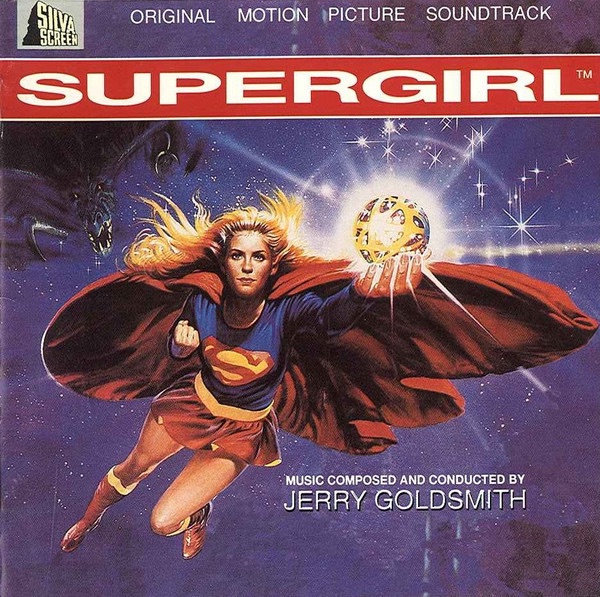
One of the better and more underrated elements of the film. The movie was set to come out in the summer of 1984 alongside an already packed slate of films that included anticipated sequels such as Indiana Jones and the Temple of Doom and Star Trek III: The Search for Spock, as well as first-run hits such as Ghostbusters, Purple Rain, Red Dawn, The Adventures of Buckaroo Banzai, Revenge of the Nerds, and The Karate Kid. Even Christopher Reeve’s film version of The Bostonians came out that summer as well. But early test screenings that April proved to be lackluster. The original cut of the film, which ran 138 minutes in length, was cut down to 124 minutes. And the Salkinds butted heads with Warner Bros. executives. The Salkinds felt that their film should be released at Christmas, owing to the success of the first Superman at that time. Warner Bros. thought otherwise. As a result, they dropped all distribution rights to the film, and Tri-Star Pictures acquired the rights, and the film would be further cut down to 105 minutes for its eventual release in the United States later that year.
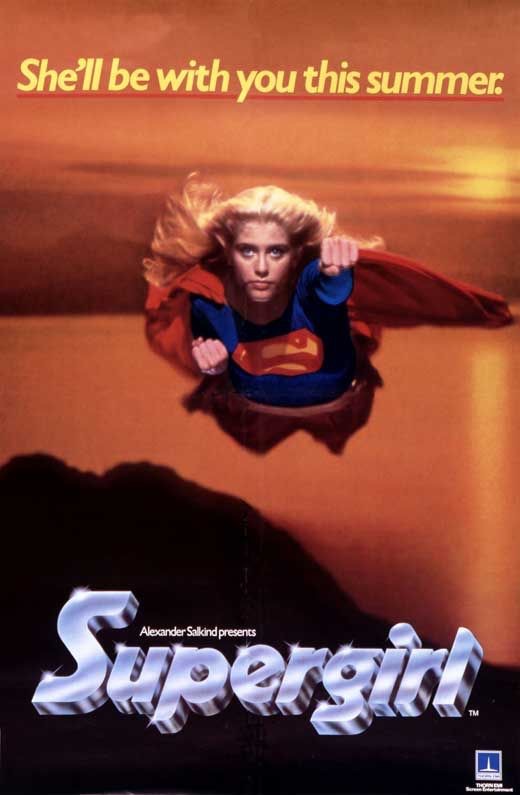
For the summer of ‘84? Similar to the reverse marketing campaign employed for Superman II in 1980-81, the 124-minute cut of Supergirl was released to theaters in Japan, the United Kingdom, Ireland, Germany, and many other international markets, and most viewers and critics agreed on one thing: this film did not work. In the fall of 1984, just before the US release of the film, the 124-minute cut of Supergirl was released on VHS by Tohokushinsha Video in Japan, and imported copies made their way to the United States and were made available at some video stores in Los Angeles. Tri-Star Pictures executives asked that the video not be distributed for fears that it might impact the then-upcoming theatrical release.
Not that it would have mattered anyway. The 105-minute cut of Supergirl came out on Thanksgiving weekend in 1984 at over 1600 theaters, and in its first week took the number one spot at the box office. But poor word of mouth from viewers and critics, coupled with the release of the 124-minute cut on VHS from Tohokushinsha Video and on laserdisc from Pony Canyon Video during the US theatrical release, hurt its overall performance, and by the end of January 1985 Supergirl limped to its end with just $14.3 million in overall gross, failing to recoup a little more than a third of its $35 million production cost. To recoup some of its losses, USA Home Video released the 105-minute cut on VHS four months later. The pan-scan transfer wasn’t the best, and HBO would pick up the rights for airing in 1986 with a much better pan-scan print. (Supergirl would be one of several films that HBO would acquire with alternate pan-scan transfers that differed from their VHS counterparts, including Superman, the original Star Wars, and St. Elmo’s Fire, among others. If anyone has copies of these HBO prints, let me know!)
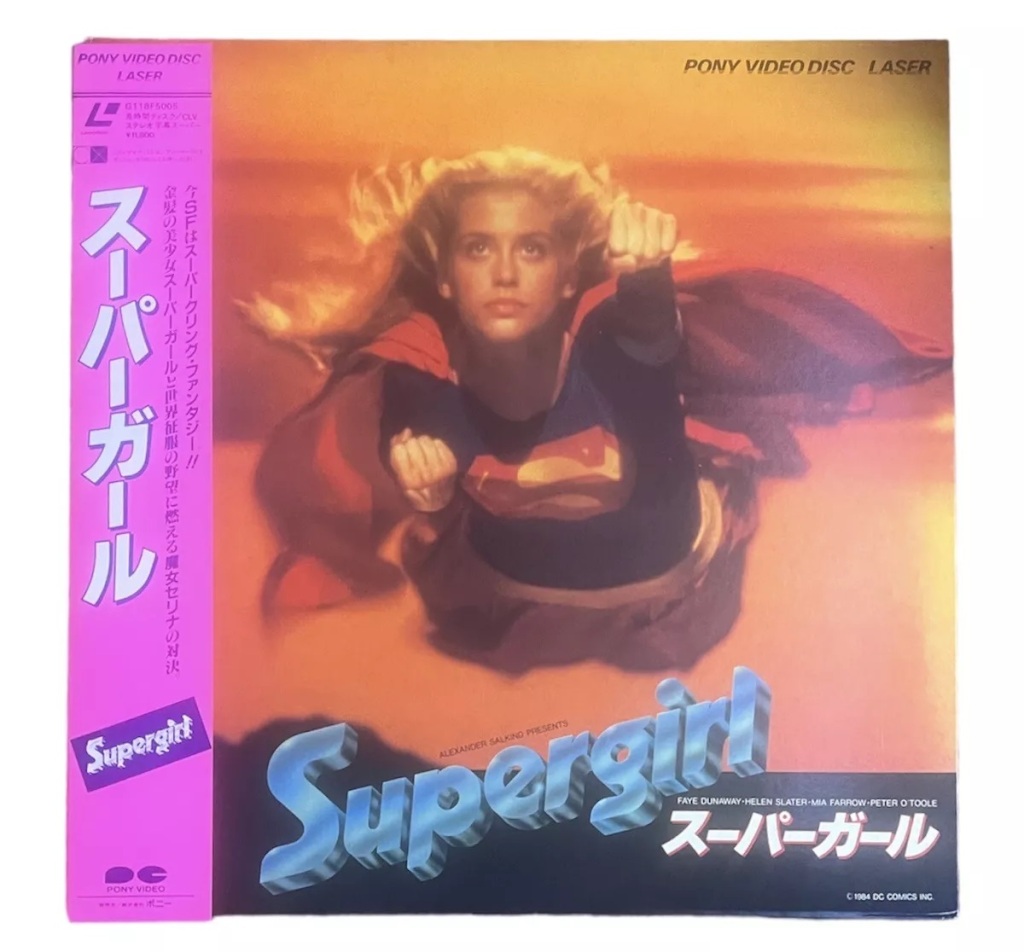
The 124-minute international version of the film on laserdisc from Pony Canyon Video in Japan. It wouldn’t be until the end of the 1990’s that the 124-minute international print would finally be issued on VHS from Anchor Bay Entertainment, although it was advertised as running 114 minutes long. It turned out to be sourced from a PAL transfer and actually ran 120 minutes. Then in 2002 Anchor Bay issued what would become a sought-after collector’s item for home video buffs: a two-disc set that included both the 124-minute international cut and the original 138-minute director’s cut, sourced from a surviving print. (Both cuts would also be released as separate discs.) The set also included a generous amount of bonus features, including an audio commentary with Jeannot Szwarc, a making-of documentary that aired on ABC at the end of 1985 in a four-hour block (along with the second broadcast of the extended TV cut of Superman II), five theatrical trailers, three TV spots, storyboards, promotional posters, a photo gallery, and a collection of talent bios. (I don’t know why I didn’t get it at the time, and it wouldn’t be until Christmas 2022 that I finally added it to my collection.)
In November 2006, as part of its “Year of Superman” promotion, Warner Home Video finally acquired the rights to Supergirl and released the 124-minute cut on a single-disc DVD, with just the audio commentary and the US trailer included on the disc. Then in the summer of 2018, the Warner Archive Collection released a two-disc set featuring the international cut in Blu-Ray format and the director’s cut in standard definition format. For all intents and purposes it seemed to be the last word on Supergirl.
In 2006 Slater reflected on her time in the role. “I did a movie after Supergirl called The Legend of Billie Jean, and even in that film they got it a little bit more right about an 18-year-old, 17-year-old going through certain rites of passage. And I felt like in Supergirl they were shying away from it, I think, just because there was so much money in the film and so much expectation that they couldn’t really explore a girl’s journey. And my wish is that now they would revisit that kind of story and find a way to tell it with depth and humor and a story that you can actually follow.”
Szwarc also had an honest reflection in 2006 on the film’s overall failure. “The film didn’t do well except in certain territories. It didn’t meet our expectations. I don’t think we missed. I think it wasn’t what people expected.”
It wouldn’t be the last time we would see Supergirl in live action formats. The character would be revisited in the second half of the popular WB/CW series Smallville with Laura Vandervoort in the role, and Helen Slater would appear as Superman’s mother Lara in an episode towards the end of the series. Years later there was the CW series with Melissa Benoist in the title role, beginning in 2015 and running for six seasons. Actress Sasha Calle would appear as Supergirl in the ill-received 2023 movie The Flash, and with James Gunn’s Superman movie currently in development, actress Milly Alcock is set to take over the part with the intention of spinning off into her own solo movie called Supergirl: Woman of Tomorrow.
Now for the film’s 40th anniversary we have a brand new Blu-Ray release of the original Supergirl movie from Plaion Pictures, and I’ll just cut to the chase: this is one scrumptious meal indeed!

First off, we have not one, not two, but three different versions of the film in the same set! The first disc contains the 124-minute international cut and the bonus material (which I’ll get to later), while the second disc contains the 138-minute director’s cut (which until now has only been available on a standard definition DVD in the Anchor Bay and Warner Archive releases), and the original theatrical version (which has never been issued on disc in any format!). For some reason the specs list the theatrical cut as 91 minutes long, so whether this is the same identical cut as the US theatrical release or not I am not sure. It would take comparing both versions to actually know.
As for the technical aspects, each cut of the film is presented in 2.35:1 widescreen ratio and mastered in 1080p for the best picture quality possible. As for the sound, the film is presented in Dolby HD 5.1 and 2.0 sound options. All versions of the film are also presented in English and German language options, and German subtitles only.
Imagine sitting down to a steak dinner, and the waiter brings you out a ribeye steak, a New York strip, and a big juicy porterhouse steak all on the same plate. Obviously one cut is going to have more meat than the other, so why not enjoy all three cuts? That’s the same feeling with this new Supergirl Blu-ray. So the only question left to ask is, which cut do you prefer?
But the meal doesn’t stop there. You also get a nice collection of sides to go with the main meal, most of which have been ported over from the Anchor Bay DVD release are included on the same disc with the international cut. This includes the audio commentary from director Jeannot Szwarc on the international cut, the making of documentary from 1985, the US and German theatrical trailers, a photo gallery, and the promotional poster gallery. The new release also contains a 20-page booklet on the history of the character and the making of the film, researched and written by Christian Heiss (who also penned the foreword and afterword for the German language version of the Superman ‘78 graphic novel collection, which is available in digital format for the Kindle app). This is presented in a very nice digibook format.
Missing in action from the Anchor Bay release are the original announcement teaser from 1983, the international and UK theatrical trailers, the three TV spots, and the collection of talent biographies, so you’re not getting all of the sides to go along with the meal. If you’re a home video completist, that means holding onto the Anchor Bay DVD (either the single disc of the international cut or the 2-disc set) to have all of the material.
Now comes the big caveat of this set. Because this is a Region 2 release, it will not play on a Region 1 Blu-ray player, so your only bet will be to get a good region-free disc player if you don’t already have one. That’s the only way to watch this new release. Also, because it is a German import, be prepared to shell out the extra nickel for the good stuff. My copy set me back $67, but given the fact that all three cuts are in the same set on Blu-ray, it’s worth the extra money.
With three cuts of this much maligned and campy movie now all available on one set to choose from, it has its share of fans, and Helen Slater’s sincere and understated portrayal is still remembered to this day. It’s still campy, with quite a bit of scenery chewing still going on. But this new Blu-ray of Supergirl is the most complete version that’s out there, minus some of the side extras, and it makes me hope that the Warner Archive will eventually release the extended TV cuts of Superman II and III and the complete unreleased version of Superman IV on Blu-ray down the road. This set is quite recommended and will fit nicely alongside your Superman Blu-ray and 4K sets!
-
A few super tidbits this time around…
Up to this point I’ve covered one particular topic after another in the Superman film universe, so here’s a few quick little bits to share with you that I’ve picked up along the way…

First off, I recently completed another rewatch of the Restored International Cut of Superman II to analyze those particular scenes that were exclusive to the various TV cuts of the film (hey, any reason to enjoy yet another viewing of the film!), and I noticed something very peculiar. About midway through the film, Zod and his minions invade the tiny town of East Houston, Idaho (which is actually much further west than its much larger counterpart of Houston, Texas), and during the moment Zod and Ursa enter the restaurant, we hear the sounds of the Average White Band’s 1974 instrumental hit “Pick Up the Pieces” (how creative were they with the lyrics?!?).

“You see, you only smell strong!” In the RIC, much of the song is dialed out of the scene of Zod and Ursa inside the restaurant. I have compared this cut with the theatrical version of the film, a copy of the Danish broadcast of the extended TV cut, and the original 122-minute version of the Richard Donner Cut, and the song is indeed dialed out of the RIC. Whether this was an intentional decision by the RIC editor and his sound mixer, or whether it may simply be a sound balancing issue with my monitor, the answer is unknown as of this writing. If anyone else has seen the RIC, I would be interested in hearing your thoughts.

This week saw the first surfacings of the new Supergirl Blu-ray set in Germany. This brand new release contains not one, not two, but all three cuts of the film, including the 124-minute international cut (which was previously released on Blu-ray from the Warner Archive), the 138-minute director’s cut (which was previously available on a standard definition DVD from Anchor Bay and the 2-disc Warner Archive set), and, for the first ever on disc, the 105-minute US theatrical cut (which has never been available on disc at all). This new set also includes nearly all of the bonus features from the 2000 Anchor Bay DVD set with apparently the exceptions of the US TV spots and a collection of talent bios—small potatoes of the overall meal, to be sure—but when you have three cuts of the film, each one containing more meat than the other, it makes for quite a tasty meal indeed! It also contains a new 20-page retrospective by writer Christian Heiss (sp?), who wrote the foreword and afterword for the German language release of the Superman ‘78 graphic novel collection. A great release for the film’s 40th anniversary this year!
The only caveat is that it’s available in a Region 2 release only, so it will not play on a Region 1 Blu-ray player. Your best option would be to get a region-free disc player, but it also might play on a gaming system such as a PlayStation 4. I recently got a Region 4 DVD of Mission Galactica: The Cylon Attack from Australia, and I was able to switch the region code settings on my PS4, and it played perfectly well with no issues at all, so this might be an option as well. Once I receive a copy of the new Supergirl disc, I’ll have more to report.

A few years ago I acquired my first Superman prop replica of the 3×5 card that Lois Lane receives from “a friend”, which was developed by my friend Daniel Sanchez, who is one of the leading Superman cosplayers in the US. Up to this point I like many others had believed that Christopher Reeve had written the note on the original 3×5 card. However, at the recent Superman in Concert performance, CapedWonders leader Jim Bowers learned that it was actually written by none other than David Michael Petrou, the writer of the Making of Superman: The Movie paperback chronicle. Oh, the things you learn!
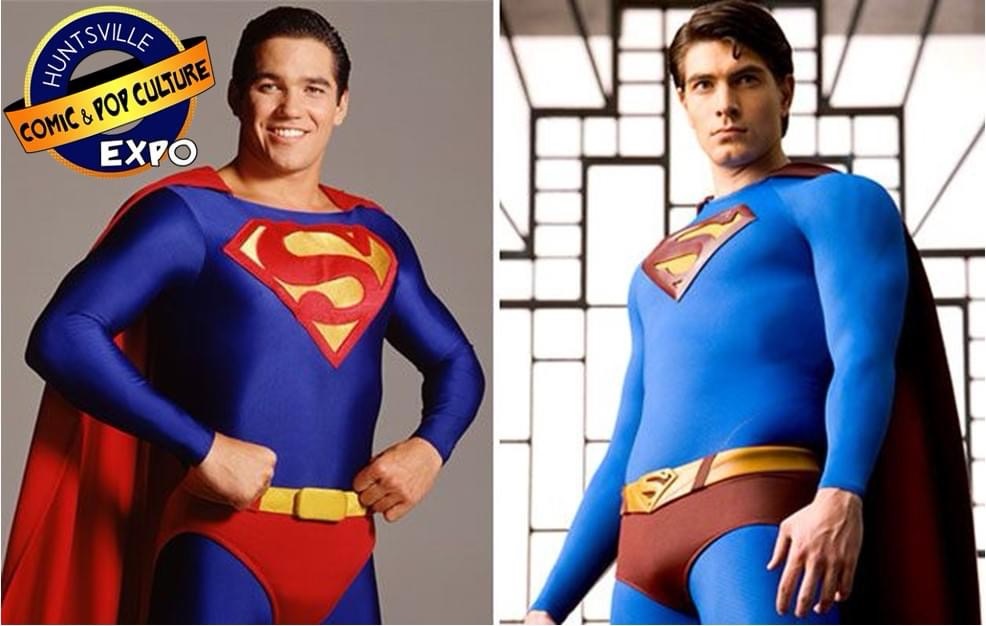
And while it doesn’t necessarily pertain to the Superman movies, I would be remiss in saying that former Superman actors Dean Cain from Lois and Clark and Brandon Routh from Superman Returns will be part of an all-star lineup at the Huntsville Comic and Pop Culture Expo next month on April 12-14! The lineup will include dozens of actors, comics creators, and athletes, including George Takei, Jonathan Frakes, Lindsay Wagner, Alessandro Juliani (from Battlestar Galactica and Smallville), Star Wars actors Dee Bradley Baker and Taylor Gray, former WWE star Trish Stratus, AEW Star Orange Cassidy, and dozens more. It’s going to be jam-packed, and I plan to go, so if you’re local, maybe I’ll see you there!
-
Crossovers – Part 3

Christopher Reeve: actor, writer, director, producer, activist… music video star? It’s been a while since I’ve posted, hasn’t it? Well, a lot has happened in my life since my last blog. To boil it down in a nutshell, life happened. For a time I lost my mojo, my will to write. It felt like for a time, maybe this is it. Maybe there’s nothing left to write about or talk about. Is there nothing more?
And then I noticed something interesting happening. A lot of people started liking my blog page on Facebook. That means that there’s more people out there who are hungry to know more about the Superman movies and wanting some fresh content about the Man of Steel, especially now that we’ve crossed the 45-year mark at the end of 2023. And as we move through 2024, maybe there is a lot more that we have yet to explore. Especially now with the incredible reviews coming from the Sundance Film Festival about the new documentary Super/Man: The Christopher Reeve Story, which should get a wide theatrical release and an eventual distribution on physical and streaming media, thanks to the recent announcement of Warner Bros. Discovery’s $15 million acquisition of the documentary. Then there’s Reeve’s final acting performance in the Smallville episode “Legacy”, which is a fitting title for his own legacy and time in both this world and the Superman franchise. Then there’s Superman in concert, special concert screenings of the film with a live performance of the iconic John Williams score. And so much more to come this year.
But let’s start with something interesting that you may not have stopped to think about. There was that one time when Superman made a multiverse crossover with none other than the Ghostbusters.
In the summer of 1989 Ghostbusters II hit movie theaters. The year was already packed with sequels almost left and right—Lethal Weapon 2, Indiana Jones and the Last Crusade, Star Trek V: The Final Frontier, The Karate Kid III, and Licence to Kill among them all jockeying for screen supremacy—but everyone was eclipsed by the phenomenon that was Batman that year. And Ghostbusters II was thrown into the mix.

To promote the film, R&B singer Bobby Brown performed the song “On Our Own”, which was featured in the film, and a music video was produced for airplay on MTV (yes Virginia, there was a time when MTV actually played music!). Like the chart-topping song from Ray Parker Jr. for the first film, the Bobby Brown video featured numerous cameos from not only Rick Moranis of Ghostbusters II but other well known celebrities including Donald Trump, Jane Curtin, Lori Singer, Iman, the Ramones, Sally Kirkland, Victoria Jackson, and billionaire Malcolm Forbes.
And smack in the middle of the video was none other than Christopher Reeve himself, riding his bicycle through New York City and pausing for a moment to smile. Check it out at the 1:14 mark.
The film made a decent profit, earning over $112 million at the box office and an overall $215 million worldwide return on a $25 million budget, no small potatoes indeed. And to think that Cannon Films’ proposed Superman V was scheduled for release in the summer of 1989 – it would have gotten lost in the shuffle of all the other sequels that year.
And it would be nearly thirty years before the franchise would be rebooted, followed by two sequels to the original, including the forthcoming Ghostbusters: Frozen Empire.
So far, “On Our Own” marks the only time that our beloved Man of Steel appeared in a music video.
-
Superman and the Legacy of “Kingdom Come”

With the release of the latest issue of the Superman ‘78: The Silver Curtain, it’s got me thinking about another popular comic book series that took its inspiration from the Christopher Reeve films in ways both heartfelt and even subtle.
I picked up the trade paperback of the landmark DC Comics graphic novel Kingdom Come for my birthday last year. This highly popular and acclaimed four-part 1996 series, written by Mark Waid and lavishly painted by Alex Ross, translates the Book of Revelation into the comics medium and sets it in a possible future where super powered beings run amok across the Earth, and it takes bringing the big three—Superman, Batman, and Wonder Woman—out of retirement for one final battle that will determine the fate of the planet.

At the heart of the tale is Norman McCay, an elderly widowed minister clearly inspired by Ross’ own father, the Reverend Clark Norman Ross, who must bear witness to all of the calamity, and who is tasked with making the judgment of who is at fault for all that has gone wrong in the world. McKay sees the world unravel and eventually warns the heroes of the horror that is about to come, quoting from Revelation as his warning. Ultimately, Norman McCay must convince Superman to, as he puts it in one seminal moment, “make the right choice, and make it as a man.” But even as the forces for good prepare for a super-powered Armageddon, so do a collective of the world’s greatest supervillains led by Lex Luthor, who has an ace up his sleeve and a mole in his midst.
Of course, it goes without saying that Ross’ take on the Man of Steel was clearly inspired by Reeve. In an interview on the Smallville second season DVD in 2003, Ross offered up his thoughts about how Reeve’s casting and portrayal would inspire his artwork:
“Christopher Reeve’s casting in the Superman film is such a pivotal point in comic history as well as film history in that such an appropriate actor was put into the suit of a fictional character, that he really electrified the legend of the character even more by his attractiveness as a male model type of guy, but his clarity of performance, the physicality of course he brought to it, and then of course he’s the first guy actually playing two separate people in these roles. (He) tried to make it convincing that you could be mistaken as to knowing Clark Kent and not thinking that’s the same guy, and he pulled it off.”
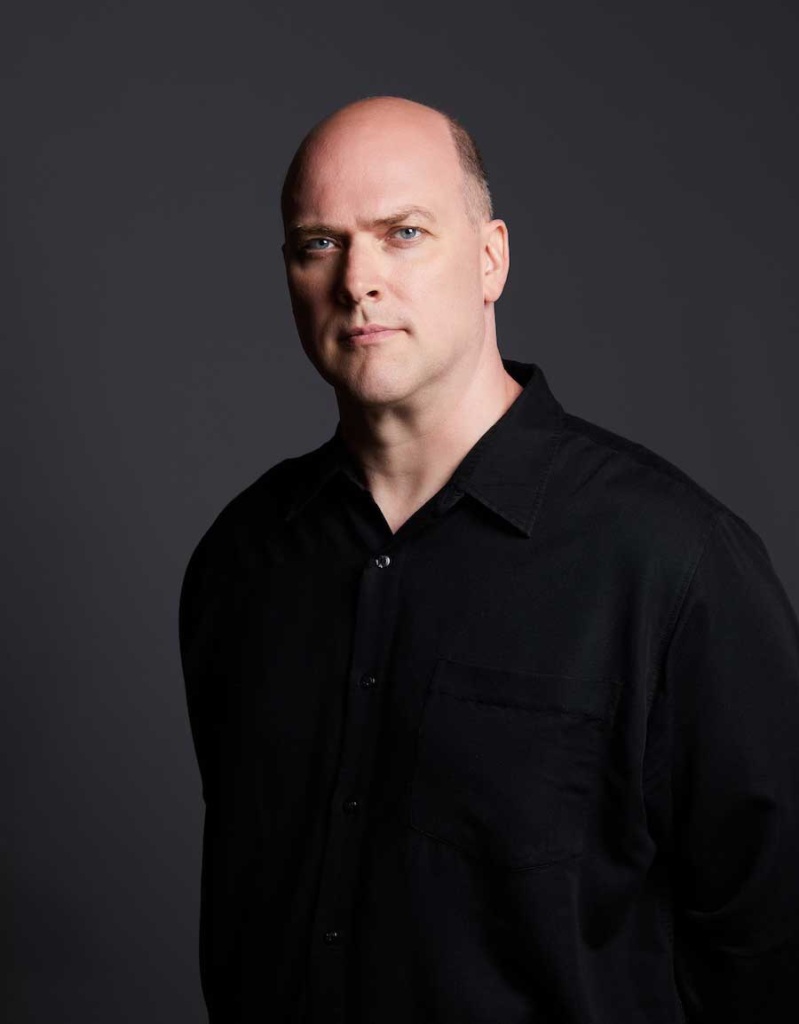
And Alex Ross’ success is well deserved indeed. His photo realism throughout his comics and covers have brought him numerous awards in the comics industry, putting him on a level comparable to the great Norman Rockwell and his decades of artwork for the Saturday Evening Post.
If you were to sit down with a copy of Kingdom Come, you would find a world rich in detail and inside jokes and references to the history of DC Comics and its many decades of film, television, and animation. And there’s lots of them indeed! Not to mention Ross’ tip of the hat to DC Comics’ creators, his own mother and artist Lynnette Ross (who makes two appearances throughout the tale), Carroll O’Conner, Linda Hamilton, the elderly couple from Grant Wood’s American Gothic, Fat Albert and the Cosby Kids, Bjork, and the Beatles. Look very carefully and you’ll find references to Sgt. Pepper’s Lonely Hearts Club Band and even a character called Nowhere Man in the story!

Covers to the original four issues of Kingdom Come. When the series was first released, it came out in four 48-page volumes originally published under the Elseworlds banner. Later collections would see the entire series published in one book and expanded by twelve pages, with a four-page sequence of Superman on the planet Apokolips in the second chapter and an eight-page epilogue in which Ross would unleash a plethora of Easter eggs left and right. This would be followed by a trading card series from Skybox that included six pieces of exclusive artwork along with panels from the story, as well as a novelization of the series. Later volumes would be expanded to feature original covers, sketches, character descriptions, essays about the series, a three-page takeoff of the series, and original story and script treatments for the first issue. That’s how big this story has taken off and taken a life of its own, rightfully earning five Eisner and Harvey awards in the comics industry.
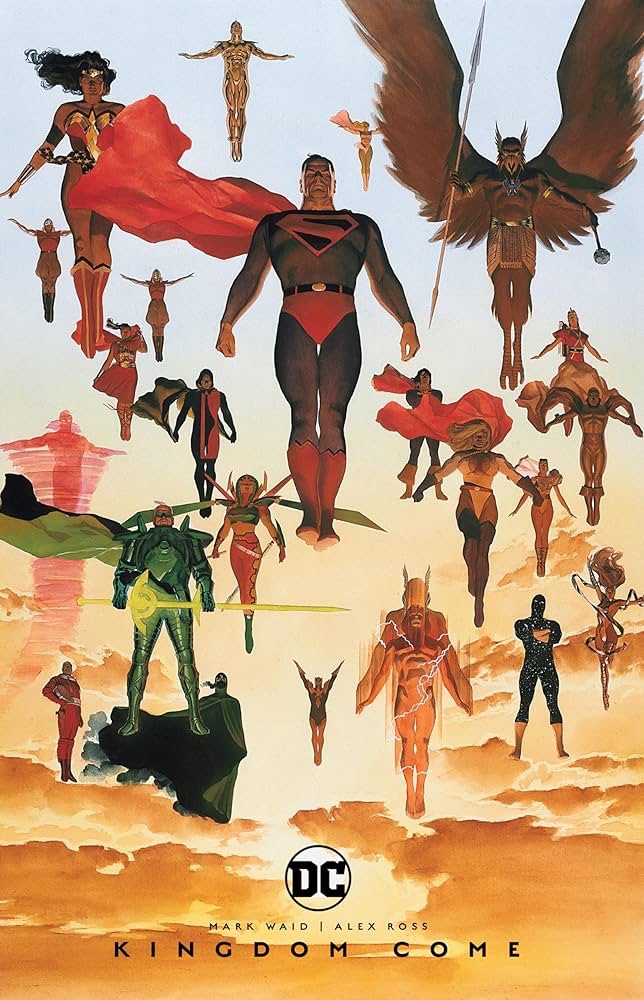
The copy I found last year for my birthday. So where can the Superman film references be found in Kingdom Come? Let’s find out, shall we?
First, we have a very fitting tribute to Christopher Reeve at the start of the volume. While it wasn’t at the beginning of the original first issue, all collections since then have included this simple tribute at the start.

A similar tribute was also included at the start of Superman II: The Richard Donner Cut in 2006. Next up we have a two-for-one special that occurs very early in the first chapter. As Norman McCay walks along the streets of Metropolis, he passes by a wrecked taxi, and its driver looks fit to be tied. Does that taxi driver look familiar? He should… it’s none other than Jack O’Halloran, best known as Non from the first two Superman films! And that wrecked taxi is clearly inspired by its run-in with a certain mild-mannered reporter. I guess Non eventually made his way into society without his powers after all!

Makes you wonder what happened to Zod and Ursa in this alternate future… Towards the end of the story, once the war is over, Norman McCay confronts Superman once again at the United Nations building (which looks suspiciously like the Hall of Justice from the Super Friends animated series). He explains to the Man of Steel what needs to be done next. And his very words are a throwback to an iconic moment in Superman: The Movie when a young and broken-hearted Clark Kent stands at his adopted father’s grave:

The final inside joke comes at the end of the story in the epilogue, which takes place one year later. Here, Clark Kent and Princess Diana meet Bruce Wayne in the clearly inspired restaurant Planet Krypton to catch up and share some news. It’s in this epilogue that Alex Ross clearly lets everything hang out, with dozens of cameos and inside jokes left and right across the eight pages. He even managed to work himself into the story as an angry long-haired guy pointing his finger at several people!
But buried in the background of the epilogue is another reference to the Superman films, and unless you have really good super peepers, or if you looked at the list of references in the epilogue, much less the entire book, you’ll notice part of a certain film poster cleverly worked into the story.
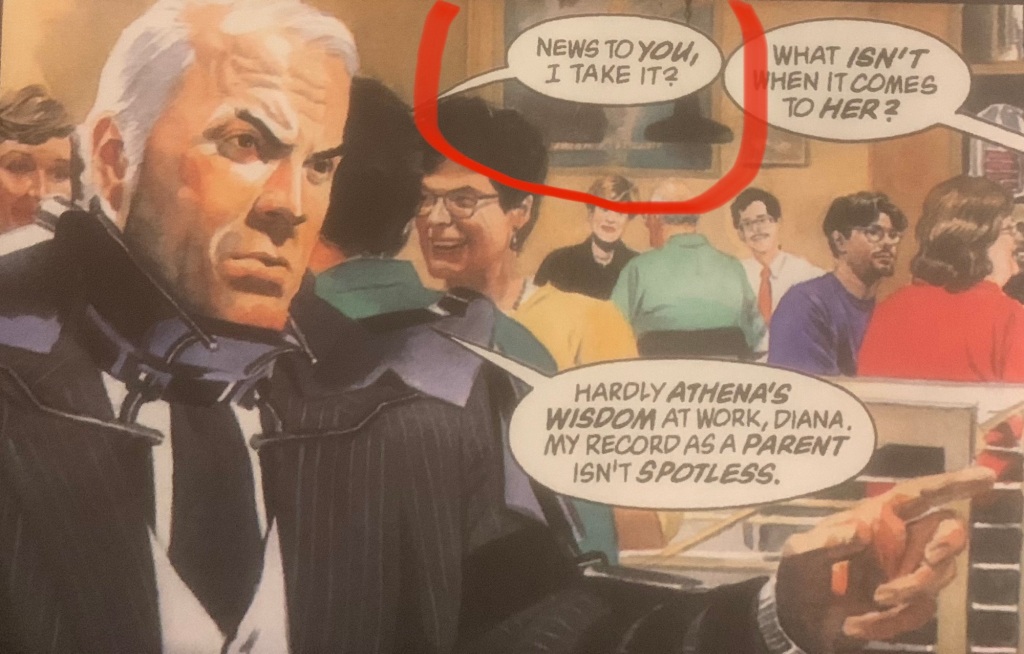
Yes, none other than Bob Peak’s classic artwork for the theatrical poster to Superman: The Movie, complete with the equally classic tagline, “You’ll believe a man can fly.” These references are prime examples of the films’ influences on Alex Ross and one of the most seminal stories of the 1990’s. It’s a must own for any movie and comic book fan.
-
Remembering Chris

Artwork by Marshall Ramsey which appeared in my hometown newspaper The Clarion-Ledger. It’s still hard to believe that it was on this day in 2004 that we lost Christopher Reeve.
Very few times in my life have I experienced the weight of that kind of loss. Losing a grandparent or aunt or uncle is one thing. Losing a beloved parent, or a spouse, or a sibling is of a different nature.
Christopher Reeve had been my boyhood hero, someone that I wanted to be like when I grew up. As Superman he was tall and built and confident, and you could hear it in his voice when he spoke on screen and off. So much so that from the time the first Superman film came out, I wanted to sound like him, and I deliberately trained my voice to sound similar to his.
Of course, I followed his career through the 1980s and 1990s whether on film or television, and most certainly through the Superman movies that followed. But when he suffered his accident in 1995, for a time I couldn’t watch the films. It just seemed impossible that someone who appeared larger than life could be injured and unable to move his entire body.
But then he made giant strides to regain his mobility and his life, even if it seemed like a snail’s pace at times. Writing, directing, and a return to acting were all part of who Reeve was, and in the process he found a new and greater purpose in his life. And after a time I found my way back to the Superman films once again.
All that changed on October 10, 2004.
I actually didn’t know that he had passed until the following morning when I drove to work and heard Paul Harvey say those words: “Superman is dead.” And my heart sank in a million pieces. I hadn’t felt that significant a loss since my dad’s death in 2002. And part of me wonders if people felt the same way when another famous Man of Steel, George Reeves, had died in 1959.
And there was only one thing that crossed my mind: call Jim.
My friend Jim Bowers had gotten to meet and know Reeve since the 1990s, and that night we talked and shared stories about Chris. Jim had even told me that Chris refused to see a print of the extended version of Superman IV, the memories of that time in his life still a painful one to remember or discuss.
But our generation still remembers. We still remember how a young man transformed himself into the embodiment of a hero on screen and off, and his impact on the superhero film genre is as big as is his mark on spinal cord research.
-
Another Variant Cover
With the forthcoming release of the second storyline in the Superman ‘78 series, you would think that there would be plenty of variant editions out there for both series.
This past week the Superman Homepage website dropped the announcement for the latest variant cover of the first issue of the original series, and this one has definite film inspirations to it.

Look closely at the illustration. See anything familiar? In October, in time for the New York Comic Con, Big Time Collectibles will release a new foil cover variant of Superman ‘78 #1, and this one should be popular for fans and collectors alike. Illustrated by Mico Suayan, who designed the Jim Lee-inspired variant cover back in 2021, this newest variant takes inspiration from two different sources. The skies and colors in the background harken back to the classic Bob Peak poster artwork from 1978, while the image of our Man of Steel in flight is referenced from the June 1978 photograph taken in New Mexico and later adapted and modified by Jim Bowers and Ramon Casares that has appeared on the lenticular cover for the Superman Ultimate Collector’s Edition DVD set in 2006, the 2018 Hallmark ornament, and other places.
Wilfredo Torres, the artist for the first Superman ‘78 series, received a copy of the variant cover and shared it to his Instagram page, saying, “Photo really doesn’t do the foil cover justice.” With an endorsement like that, we’re all in for a treat indeed!

NYCC is set for October 12-15, and while the MSRP has not been announced yet, based on the different foil cover variants of other comics on the Big Time Collectibles website, I’m thinking it’ll be around $29.99. One thing is for sure, I plan to pick up this movie-inspired collectible when it comes out!
(And how about those foreign language versions that are out there? There’s the Spanish version entitled Superman 1978 which came out in 2022—I’ve tried to find a copy of it, but it’s apparently very hard to obtain. I myself have a German language digital version for my Kindle that was released through Panini Comics, and I’ve even seen one in Korean that I plan to add to my collection!)
9/13/23 update: I just learned from my friend Jim Bowers that the new Mico Suayan variant cover will be a limited edition of only 1,000 copies. Given that I was able to get a limited edition version of another Superman comic, my thinking is that half of them will be available at NYCC, and the other half will be through Big Time Collectibles. Be ready to get this one, because it will go fast!
Also, Jim informed me that there will be yet another variant cover issued at the same time, this one a straightforward cover of the classic Bob Peak poster artwork. That one I’m sure will go equally fast, too. This version, too, is also limited to 1,000 copies.
And here’s the best part: preorders for both editions will occur on the Big Time Collectibles website beginning Friday, September 29th! You’ll want to add these beauties to your collection… I know I will!
Thanks for the updates, Jim!
-
Superman ‘78 is Back!

Cue the John Williams music! The news dropped yesterday out of nowhere, and on one hand it was what we were expecting to hear for the past year, and yet on the other hand we definitely didn’t see this coming yesterday. And I have to give credit to my friend Jim Bowers and the CapedWonder Superman Podcast for being the first to drop the news to the world, at least before I had a chance to see it elsewhere.
Superman ‘78 is coming back this year, in time for the 45th anniversary of the release of Superman: The Movie as well as the climax to the 85th anniversary of the birth of the Superman franchise!
We had known that there would be a sequel to the highly successful Superman ‘78 series since the release of the hardcover collection, when it was teased that writer Robert Venditti was developing a second storyline set during the Christopher Reeve movie series. And after the incredibly spectacular storyline against Brainiac, the field was wide open for more stories to tell.
Now we have our first sneak peek at the second series, Superman ‘78: The Metal Curtain, an all-new six-part storyline which will debut on November 7th. Joining Robert Venditti this time around is artist Gavin Guidry, who has worked on Captain America: The Ghost Army for Marvel Comics and illustrated covers for Army of Darkness, Teenage Mutant Ninja Turtles, and Transformers: Beast Wars, among others. Gavin will bring his unique visual style to the Reeve franchise, aka Earth-789 (named in honor of the Superman films and the Tim Burton Batman films).

In the first issue, we will see how another fragment of the planet Krypton landed in the Soviet Union and how the Russians take advantage of the discovery to create their own weapon of destruction to use against the Man of Steel. Then in the second issue, which releases on December 5th, we see that weapon of destruction, entitled Metallo, unleashed against Superman. As we know from established comics lore, the Superboy TV series, Superman: The Animated Series, and Smallville, Metallo is driven by kryptonite, so any contact with Superman will immediately weaken him. So it’ll be interesting to see how this version of Metallo will go up against our hero in this series. Expect the next chapters to street through the first third of 2024, respectively.

Of course, it wouldn’t be a Superman ‘78 series without a plethora of variant covers, and The Metal Curtain will be no exception! The first issue will have no less than six variant covers, including the standard version, a variant cover by our fan-favorite artist Wilfredo Torres, a 1:25 variant cover from artist Doug Braithwaite, a 1:50 variant cover by artist Adam Gutierrez, a blank white sketch cover for your favorite artist to customize, and a Todd McFarlane action figure variant. (And don’t be surprised if variants of those variants pop up in the wild somewhere.)

A preview of the Wilfredo Torres variant cover, with a beautiful image inspired by Superman III. The second issue will have three cover versions, including the standard cover, a Michael Cho variant cover, and a 1:25 Max Dunbar variant cover. So bottom line, if you’re like me and you want all of the cover variants, put on your Indiana Jones hat, hit the comics shop, search out the different online stores, and (to borrow from Pokémon) catch them all!
And of course we can expect digital versions to drop for the Kindle and iTunes libraries, as with the previous series, so I plan to pick those issues as well. As for a hardcover collection, I wouldn’t be surprised if we see it down the road next year.
So start saving up your dollars especially for all of those cover variants, because like with the first series, this will be another big hit with the fans, I’m going to call.
-
Superman: Solar – A Commentary

You don’t see too many fan films based on the Superman franchise. Usually when you hear the term “fan film”, what immediately comes to mind are the plethora of Star Wars fan films which expand upon that galaxy far, far away and delve into deeper, original characters and their own experiences with the Force. And then there’s the plethora of Star Trek fan productions which grew from low-budget appreciations of the franchise in the early 2000s to larger, more expensive and even crowdfunded projects over time—some great (Yorktown: A Time to Heal), some not so good, and some which left a bitter taste in people’s mouths that resulted in guidelines being enacted so as not to conflict with the current regime of television productions. (One word: Axanar.)
But you don’t see too many based on the last son of Krypton. In the 2000s there was a World’s Finest teaser film from writer-director Sandy Collora (who is best known for his short film Batman: Dead End), which brought together Superman and Batman years before the massive Batman vs. Superman: Dawn of Justice feature film. And earlier this year there was the CGI animated film Superman Awakens, which was a stunning five-minute piece that just blew my mind away.
That’s not even counting the different fan recuts of the Christopher Reeve movies that have brought him into contact with Batman, Supergirl, Wonder Woman, and others. And there are a dozen other fan films both short and full-length that are out there, all in varying degrees of quality.


These are the others that I came across. Now comes Superman: Solar, a new fan film project from writer-director Andrew List that takes a look at the man behind the Man of Steel and addresses an extremely important and sensitive topic.
In this 30-minute project, we find our hero, portrayed here by Glenn Kiil, making his way into the world as Superman first, complete with his homemade costume that his adopted mother Martha Kent has made for him. She fusses at him because he’s spending his Friday nights at home designing the costume rather than going out to root for the Smallville Eagles in their quest for the state football championship. But he wants to go out and make a difference in the world, whether as the Man of Steel or as Clark Kent.
Here, a couple of Smallville’s residents know that Clark and Superman are one and the same after spotting him on television, but, because of the goodness of the Kents in their lives, they promise to keep Clark’s dual identity a secret in turn.

What Superman: Solar succeeds in is expanding on the little moments that make the man in him. Whether he’s fixing a little boy’s bicycle, or playing baseball, or pausing from flight to reflect on his own values, or listening to the wisdom of his father Jonathan Kent, these moments are reflective of what Richard Donner established in the first Superman film.
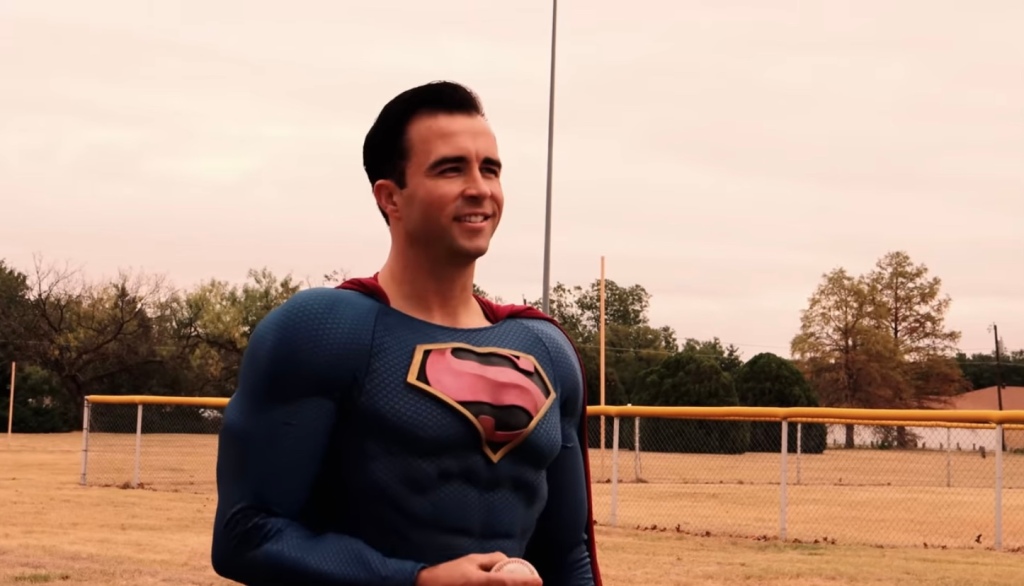
Of course, it wouldn’t be a Superman story without its share of action sequences, including a brilliant fight between our hero and Brainiac. The Kryptonian super computer being has always been one of the most difficult characters to bring to life on screen, and it’s been in recent programs like the animated series from the 1990’s and live action series such as Smallville and Krypton that we’ve seen Brainiac in action. But not in a film.

But it’s more than just action that drives this story. At the heart of it is Superman coming to the aid of a young man who has contemplated committing suicide because no one understands him. And it is here that Superman not only reveals his name of Clark to the young man, a total stranger, but he also shared what his father told him: “You only fail if you give up.” This is the core of who the Man of Steel is, and it’s good to see this side of him come forth again. It’s like it’s gotten lost in the recent years and films.

And yet, Superman: Solar has its share of Easter eggs and nods to the original Superman film, including two appearances of a certain newspaper headline…


To quote Perry White, “We’re sitting on the story of the century here!” …and the inspirational words from Jonathan Kent to his son Clark that have become a touchstone for the character to this day…

“You are here for a reason…” But there’s also one part of this production that stands out, and it’s the appearance of longtime Superman actor Aaron Smolinksi. Here he gets the role of a lifetime as Superman’s arch nemesis Lex Luthor, and he rises to the challenge of meeting the Man of Steel head on as his intellectual superior. I have been excited about seeing my friend in this project ever since the announcement was first made, and it makes me long for a sequel. We can’t wait to see you back in action, Aaron!
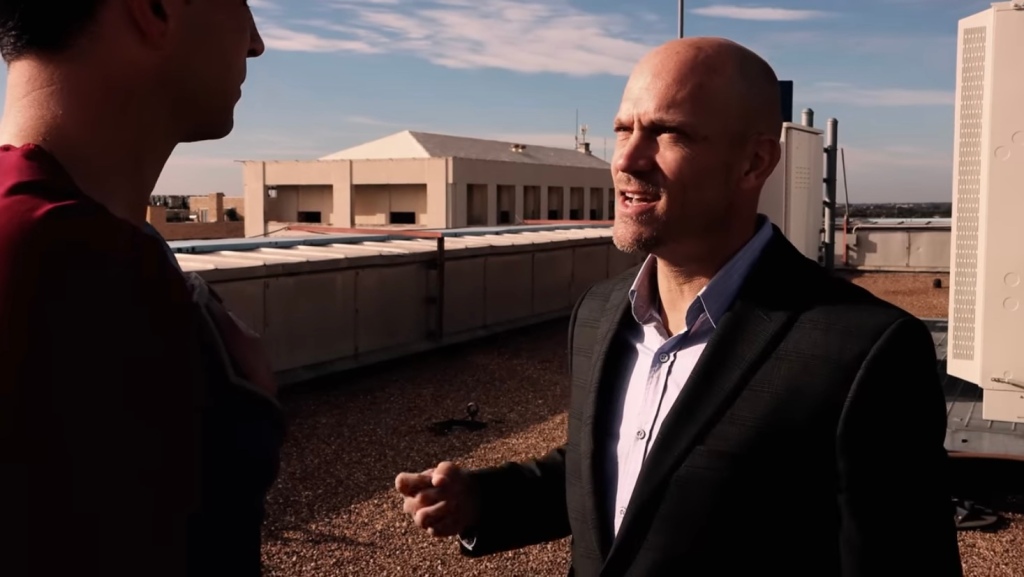
There’s even a little post-credits Easter egg reference to the music of Danny Elfman. Just saying!
What Superman: Solar has going for it is heart, and that’s where Andrew List’s short film succeeds. As I said, it makes me long for a sequel. So check it out. You may be pleasantly surprised.
-
Gene Hackman is Back!

It came as a surprise in my email, and I like good surprises. So it took me by surprise when I read the news that Official Pix is preparing for another autograph signing with the one and only Gene Hackman!
This is the fifth signing that Official Pix has done with Mr. Hackman, and for the second consecutive year CapedWonder.com and the CapedWonder Superman Podcast is partnering with Official Pix to make this happen, which will occur in September. This time around, more rare pictures of Lex Luthor and the Superman cast will be made available.
As you know, Gene Hackman has had a diverse career in Hollywood, with many films such as The French Connection, The Conversation, Unforgiven, Crimson Tide, Hoosiers, Mississippi Burning, Young Frankenstein, and of course his three times as criminal mastermind Lex Luthor in the Superman film series to his credit. Drama, comedy, hero, villain, you name it, his ability to get into the interior motivation of any character he has portrayed works its way to the screen to where you believe him as “Popeye” Doyle, the vicious Little Bill, or even the charming yet dangerous Luthor—all of it shines in his acting.
Last year I was able to send in a prop replica of the Daily Planet newspaper headline from the beginning of Superman II: The Richard Donner Cut for him to sign, which became my big Christmas present to myself.
And I have to give a big thank you to Chris Wyman at Official Pix. He answered all of my questions about the signing in a quick and timely manner, and the professionalism he oversaw in returning my prop newspaper with the Official Pix holographic seal of approval guaranteed me that I would have a 100 percent genuine Gene Hackman autograph for my Superman collection. That’s how good they are.
Orders are currently being taken through August 28th, and any items that you choose to send in must be sent by August 31st for the September signing with Mr. Hackman. Pictures, posters, magazines, videos, books, you name it, anything that would make for a perfect addition to your Superman collection. For me, it would be this…

“It’s fantastic!”
